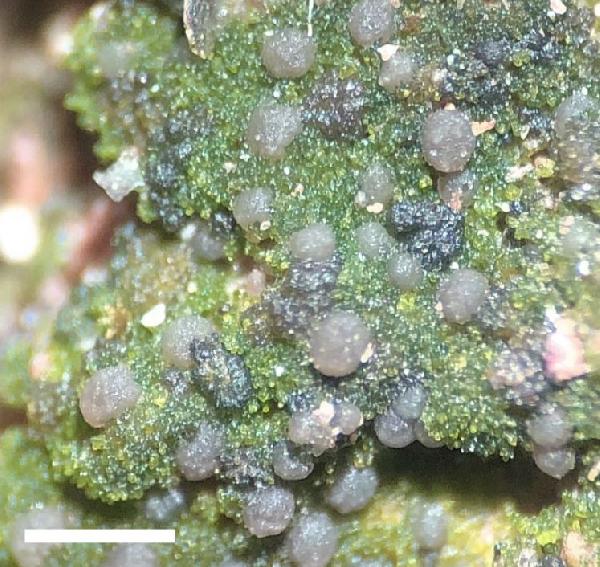Aphanopsis coenosa (Ach.) Coppins & P. James
Lichenologist, 16: 248, 1984. Basionym: Collema coenosum Ach. - Lichenogr. Univ.: 629, 1810.
Synonyms: Aphanopsis terrigena (Ach.) Nyl ex P. Syd.; Biatora comensis Anzi; Lecidea comensis (Anzi) Jatta; Lecidea humigena Taylor; Lecidea praecox Vězda; Lecidea terrigena Ach.
Distribution: N - Lomb (Anzi E. C. I. II 1123: Printzen 1995).
Description: Thallus crustose, poorly delimited, dark green to green-brown, gelatinous when wet, pseudoparenchymatous, consisting of goniocysts surrounded by hyphae, the outer ones with brown-pigmented walls. Apothecia micareoid, 0.2-0.6 mm across, with a brown to brown-black, strongly convex disc, without a distinct proper margin. Proper exciple very much reduced, of a few thread-like hyphae resembling paraphyses, colourless to brownish; hymenium colourless, with red-brown vertical streaks reacting K+ dark brown, 150-200 µm high, I- (but appearing I+ blue due to the amyloid ascal walls); paraphyses simple or rarely forked in upper part, arranged in densely entangled clusters, with conspicuous septa, 2-3.5(-4) µm thick, not surrounded by a distinct hymenial gel; hypothecium pale brown, scarcely distinguishable from the hymenium. Asci 8-spored, cylindrical-clavate, with relatively thick, multi-layered, amyloid walls, the apical dome with a broad, K/I+ blue plug flattening out at maturity, opening apically with an irregular fissure. Ascospores 1-celled, hyaline to pale brown when overmature, broadly ellipsoid, sometimes apiculate at one or both ends, 25-38 x 13-18 µm, thin-walled, often guttulate. Photobiont chlorococcoid. Spot tests: thallus K-, C-, KC-, P-, UV-. Chemistry: without lichen substances.Note: on humid, bare, clayey or fine-grained sandy soil on track sides or ditch margins in deciduous woodlands, with optimum in the montane belt. Easy to overlook, but certainly not common in Italy.
Growth form: Crustose
Substrata: soil, terricolous mosses, and plant debris
Photobiont: green algae other than Trentepohlia
Reproductive strategy: mainly sexual
Commonnes-rarity: (info)
Alpine belt: absent
Subalpine belt: absent
Oromediterranean belt: absent
Montane belt: very rare
Submediterranean belt: extremely rare
Padanian area: absent
Humid submediterranean belt: absent
Humid mediterranean belt: absent
Dry mediterranean belt: absent

Predictive model
Herbarium samples

Source:Westberg, M., Arup, U., Ekman, S., Isaksson, R., Johannesson, L., Vicente, R. & Svensson, M. 2022. Additions to the flora of lichens and lichenicolous fungi in Fennoscandia. Graphis Scripta 34 (1): 12–21. Oslo. ISSN 2002-4495. - CC BY-4.0
Aphanopsis coenosa. Pale apothecia on a thallus of minute goniocysts. Photo taken in the field. Sävsjö, Södra industriområdet, 17 Feb. 2020. Bar = 1 mm.
Growth form: Crustose
Substrata: soil, terricolous mosses, and plant debris
Photobiont: green algae other than Trentepohlia
Reproductive strategy: mainly sexual
Commonnes-rarity: (info)
Alpine belt: absent
Subalpine belt: absent
Oromediterranean belt: absent
Montane belt: very rare
Submediterranean belt: extremely rare
Padanian area: absent
Humid submediterranean belt: absent
Humid mediterranean belt: absent
Dry mediterranean belt: absent

Predictive model
| Herbarium samples |

 INDEX FUNGORUM
INDEX FUNGORUM
 GBIF
GBIF




